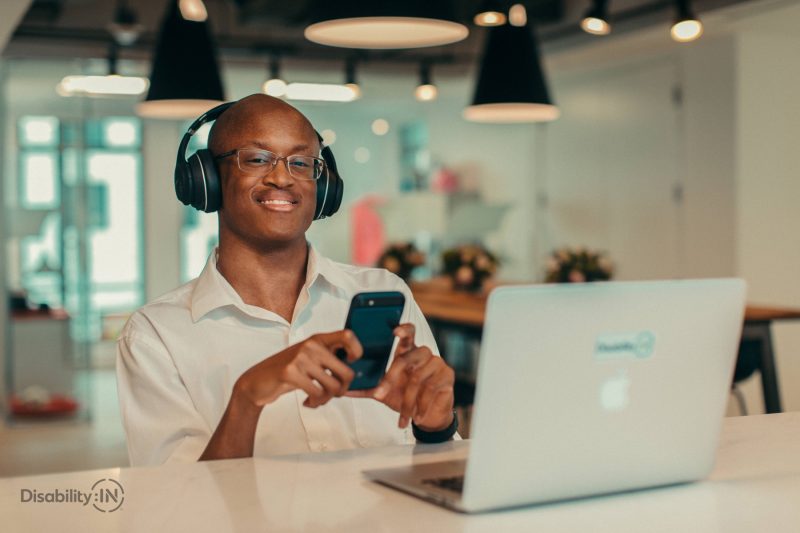Changing Workspaces- A time for inclusivity?

The office is evolving to accommodate new modern methods of working, but will employers consider everyone throughout this change?
One thing the pandemic taught us, is that if push comes to shove, many of our jobs can be done from home. In fact, after the lockdown forced us to create offices in our own houses, the term ‘workplace revolution’ was regularly used to describe this newfound approach.
As a result, many businesses naturally began to question the need for a physical office, and given the expense of central London estates, many employers didn’t hesitate to consider abolishing their traditional HQs.
It became a common occurrence to see employers adapting and reconfiguring their spaces, some even consolidating their property portfolios and closing certain subdivisions, to save on the vast rental costs.
Of course, for many people, the widespread acceptance of home working was life changing, especially for people with disabilities who had always fought for that opportunity . After all, avoiding commutes, eliminating public transport, and allowing flexitime from home, is a blessing for most people who have a disability. In many cases, it allows those employees to become more productive.
However, it wasn’t long before employers saw the flaws in long term distant working. In fact, in the last year things have started to take a different turn, with dozens of corporate giants now openly leading campaigns to get workers back into the office. Even Zoom, the video communications company that played a big part in the remote working revolution, has ordered staff to return to offices at least two days per week.
A recent US report proved exactly this when it revealed that 90% of companies plan to implement return-to-office policies by the end of 2024, some (30%) even saying their company will consider dismissing employees who don’t comply with in-office requirements! That same survey also revealed that just 2% agreed that they would continue with a remote based offering. This is further complicated by people who were hired during the pandemic specifically on a work from home basis.
Tempting Staff Back to the Office
Interestingly, a large number of organisations are opting for the carrot rather than the stick and instead of threatening workers with the sack, they are improving their office spaces, in hope of attracting staff back naturally. They are doing this by introducing ad-hoc flexible spaces, ergonomic furniture, working environments that suit more modern methods of working, such as hubs, meeting pods, and spaces that cater for tasks at hand- rather than offering one space for all. Incentives like barista standard free coffee and food are also becoming common lures to get more people back in the office, in a bid to show staff their needs can be supported, without losing the luxury and comfort of their own homes.
That all sounds great- but it strikes me that, if a workplace evolution is taking place, and so many businesses are considering new innovative designs, adding state of the art incentives and rethinking decor– that this could also be the perfect time to also consider the needs of 24% of the population - People with disabilities.
Inclusive Office Design – Best Practice For all!
One of the many values of creating an inclusive office environment is that it can benefit everyone. Modern workspace design trends currently focus on flexible, fluid, and adaptive shared spaces, that can be used as and when people enter the office- as opposed to workers having a single, set workstation, in one particular area of the office. This enables hybrid and agile workers to use the workplace on an ad-hoc basis, allowing them to experience the benefits of both home and the office.
Fortunately, this format of flexible and adaptive design lends itself well to people with disabilities. For example, if we are designing new working environments that are flexible and can be adapted for all workers- such as ergonomic desks - then making this furniture height adjustable will also cater well for wheelchair users. Similarly, other furniture and features will need to be adaptive and offer a range of settings too. Creating an environment where furniture must be suitable for all users, means people with disabilities can be better catered for, if the right choices are made.
Creating areas to suit working behaviours
Another rising workspace trend is to create micro-environments to suit the various different working behaviours individuals have. For example, some spaces are being developed for more open, informal, collaborative and creative work. In turn, quieter areas for contemplative work that requires concentration and lone working are also being developed.
Now, with just a little more consideration, a quiet environment such as this can cater excellently for neurodiverse individuals, wishing to remove themselves from busier areas. With a little consideration to colour, patterns, acoustic design and other stimuli – this can be an area that can also be perfect neurodivergent workers, should they need a quieter, less intense working environment. Employees struggling with stress elevated through noise and lack of concentration can also benefit from popular features such as private pods, quiet zones, soundproof walls and acoustic pods.
This is not of course suggesting that people with disabilities should be confined to any particular area, but if a menu of different ambiences were available, all people -both with a disability and without- can choose an appropriate space to suit their moods. After all, as humans, our moods vary regularly, and with most jobs requiring a multitude of tasks, why not have zones appropriate for each one, rather than one environment to do all?
Offering a variety of settings, temperatures, ambiences, and aesthetic designs will benefit everyone, including those with disabilities. Insurance firm Zurich recently proved this by changing its offices and creating sensory maps for each of its sites. The map shows staff members the different levels of temperature, noise, smells, and foot traffic around the workspace to allow them to choose an area to work, dependent on their needs. This was designed to aid those who are neurodiverse pregnant, managing depression or anxiety and those experiencing the menopause – and Zurich also reported that the mapping can also help provide multi-faith spaces for different cultures.
Small Changes- Big Difference
Ultimately, when changing our working environments, just a small amount of consideration will create a very inclusive space. For example, if the office is undergoing an aesthetic change, and redesign is taking place, by simply giving consideration to small touches such as the placement of switches and plug points, walkways and the widths between desks, doors, the placement of chair legs on new tables for wheelchair access, layout and lighting- will all make a huge change. Just a few tweaks will allow you to create an environment that caters excellently for all.
At a time when the office is in a process of evolution, and employers are rethinking their space to lure the workers back, let’s make sure that the changes we make are for everyone. With simple considerations, during this new phase, we can create inclusive environments that allow all individuals to thrive in their working environment, despite their needs- creating new and improved modern methods of working for every staff member. Equally, I think it is important that flexible home working remains available for those that need it.
Chris Jay, MD, Bascule Disability Training



